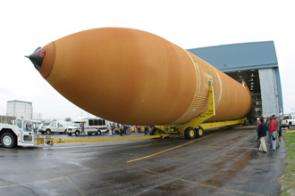NASA Ships External Fuel Tank for Next Space Shuttle Mission

In the aftermath of Hurricane Katrina, which devastated New Orleans, workers at the nearby NASA Michoud Assembly Facility persevered through their own personal hardships to deliver a newly designed external fuel tank for the space shuttle.
As a result, the tank that will help launch Space Shuttle Discovery on its next mission will head to NASA’s Kennedy Space Center, Fla., this weekend. The exact time of departure will be determined by real-time operational conditions.
The huge orange tank designated ET-119, will be loaded on a covered barge today at Michoud for shipment Saturday. The barge is expected to take five to six days to travel from the Mississippi River-Gulf of Mexico Outlet to Florida's Banana River, which flows into the Atlantic Ocean.
At Kennedy, the tank will be delivered to the Vehicle Assembly Building for final checkout and eventually attached to the twin solid rocket boosters and Discovery for its mission (STS-121) to the International Space Station. NASA managers are targeting a launch window for Discovery in May.
The tank feeds 535,000 gallons of liquid propellants – hydrogen and oxygen – to the shuttle's three main engines, which power it to orbit. For the first time, the tank will fly without Protuberance Air Load (PAL) ramps. The ramps were on the tank to protect a cable tray and two pressurization oxygen and hydrogen lines during the dynamic portion of launch, which includes liftoff through about the first three minutes of the climb to orbit. There are two PAL ramps on the external tank, one at the top of the liquid oxygen portion of the tank, which is 14 feet long and consists of 14 pounds of foam. The other is a liquid hydrogen PAL ramp, which is 38 feet long and contains 21 pounds of foam.
Following last summer’s shuttle mission, STS-114, detailed inspections, engineering analysis and testing were performed on external tanks at Michoud. As a result, the Space Shuttle Program determined the PAL ramps were not necessary and it would be a safety improvement to fly the remaining shuttle missions without the ramps on the tank.
Wind tunnel testing using the data is scheduled to begin in mid-March and continue through April to corroborate those conclusions. Additional work to the tank included minor redesign work on ice/frost ramps, the foam segments that cover support brackets at various locations along the pressurization lines. These ice/frost ramps were partially covered by the PAL ramps and were left exposed after the ramp was removed.
Work also was completed in the area of the tank's bipod fittings that connect the external tank to the orbiter through the shuttle's two forward attachment struts. The electrical harnesses that service the bipod heaters and temperature sensors were removed and replaced with improved versions designed to reduce the potential for nitrogen leakage from the intertank through the cables into the cryogenic region near the bipod fittings. To prevent nitrogen leakage underneath the cables, void spaces beneath the cables were eliminated by using an improved bonding procedure to ensure complete adhesive coverage.
STS-121’s seven astronauts will fly to the space station on the second mission in the Return to Flight sequence, which started with STS-114. Discovery’s crew will test new equipment and procedures designed to increase the safety of shuttles, deliver supplies and make repairs to the space station.
Source: NASA

















